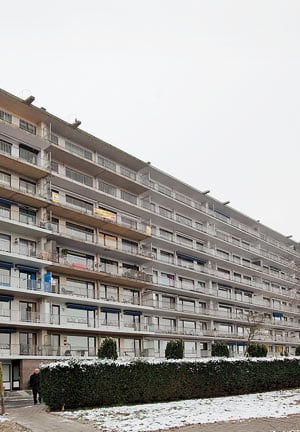Waste used for domestic heating
The Belgian city of Roeselare can rightfully claim pioneer status when it comes to expanding the benefits of district heating. For the first time in the country, a residential building (Zilverberg) is heated by surplus energy from a waste incineration facility. A umber of Mini City substations from Alfa Laval play an important role in the process.
DATE 2023-11-28Close-knit cooperation created a model case
This project shows how an urban district heating network can provide the starting point for cost-efficient expansion of district heating into adjacent residential areas. From this perspective, he Zilverberg project provides a model case for "second generation" (i.e. small-scale) applications of district heating technology.
This project was made possible thanks to a close cooperation between the apartment owners, the incineration plant, the installer and a well-known coordinator and constructor, Van Marcke Logistics. The latter is a major Belgian operator within the HVAC segment. Alfa Laval was invited to join the team, and 74 Mini City substations were selected to ensure the success of the project.
Easy connection to the present network
The project was initiated in a somewhat unusual way. The company handling the insurance for all the apartments refused to sign a new policy due to the fire hazard arising from obsolete oil boilers. Residents then decided to replace them with highly efficient gas burners. Rumours reached the municipal waste plant operator Mirom and soon a better alternative was presented jointly by Mirom and Van Marcke.
Comprehensive solution
The solution developed by Mirom/Van Marcke sounds uncomplicated when described. Excess heat from the incineration process is cooled down to 110° C. The hot water is then distributed under high pressure via heat exchangers, pumps and underground piping to the residential block. There 74 Mini City substations delivers the heat according to the needs of every individual household. An Alfa Laval Maxi module is used to separate the district heating network from the Zilverberg circuit.
Trust, performance and after sales capacity
As is frequently the case, a combination of trust and actual technical performance was decisive when the supplier of heating equipment was selected. Says Geert Spitaels, segment manager at Alfa Laval Benelux:
– Mirom and Alfa Laval have worked together for some 25 years by now. They and their partners were aware of the strong local support we are able to offer. We were also able to present a credible performance profile for the Mini City and the installation was very simple when compared to other alternatives. We were also able to calculate the cost profile for each individual apartment.
Tom Prinzie is a project engineer at Van Marcke, and was involved in the project at an early stage. He says he was convinced gradually that a solution involving Mini City would turn out the best alternative.
– Technical performance was easy to judge, but I was surprised at the after sales package that Alfa Laval was able to offer. In partnership with them, our company will henceforth guarantee undisturbed continuity within the system.
Maximum benefit from previous investments
The Zilverberg case clearly demonstrates how small networks can easily be connected to more comprehensive district heating circuits. In this case, much of the infrastructural investment cost had already been taken. The main district heating network runs fairly close to the Zilverberg building and the costs for additional pipework could therefore be kept at a moderate level. In many cases, this means a short payback horizon along with the immediate benefits of increased comfort, energy saving and low emission levels.

